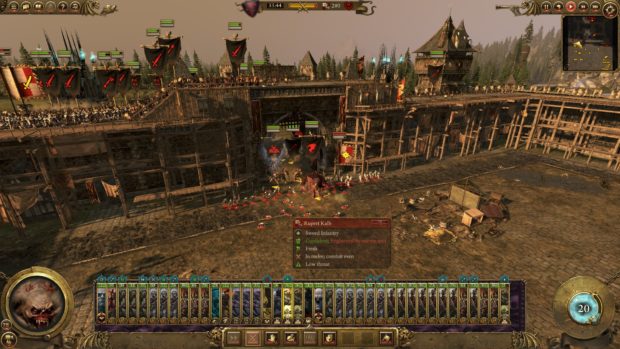I have fought many, many battles in Total War games. Yet, in the new release, Total War: Warhammer, I encountered three things all in one battle that I never had before: first, I won a battle with only three people left in my army; second, the three people I had left were leader units, who dominated the enemies that had them completely surrounded; and third, I instantly raised my army back up from the dead, so having only three people left was completely okay. Warhammer, in the context of the previous Total War games, is very much a new experience.
It has taken 10 entries to the core Total War series, but for the first time, Creative Assembly has moved away from history-inspired games and into the fantasy realm. The Warhammer universe, with its diverse races and massive battles, is an excellent fit, and the developers use the settings lore to drive the campaign, resulting in some compelling additions to the series formula. The fit is so perfect that one might be left wondering, why hasn’t there been this sort of game before?
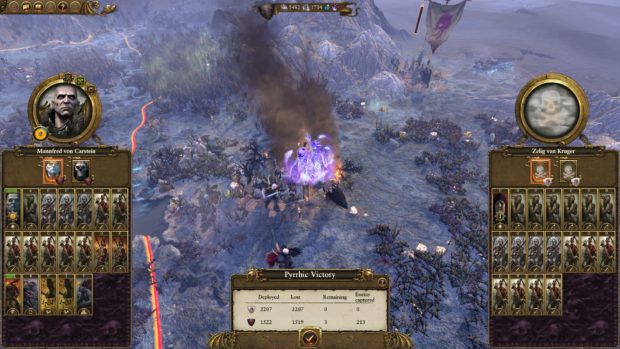
There are five races in the game, four of which are playable immediately: Dwarves, Greenskins, the Empire, and the Vampire Counts. If you pre-ordered the game or purchased in the first week, the Chaos Warriors are playable as well (if you didn’t, the Chaos Warriors are available as paid DLC, or, of course, you could leave them as the ominous threat to all the world, if you desire). In terms of playable factions, it’s a much smaller number than longtime Total War fans will be used to, but this is ameliorated by diversity. The plodding Dwarves, with their helicopters, play very differently from the Vampire Counts and their hordes of undead and complete lack of missile troops. The Vampire armies must corrupt the land they march through, lest they suffer attrition. The orcs of the Greenskins must regularly fight battles or they will start fighting amongst themselves. And the Dwarves? Good luck getting them to chase anyone down, with their complete lack of cavalry. Each faction feels so distinctive I look forward to trying a campaign with each of them, and enjoying the new experience.
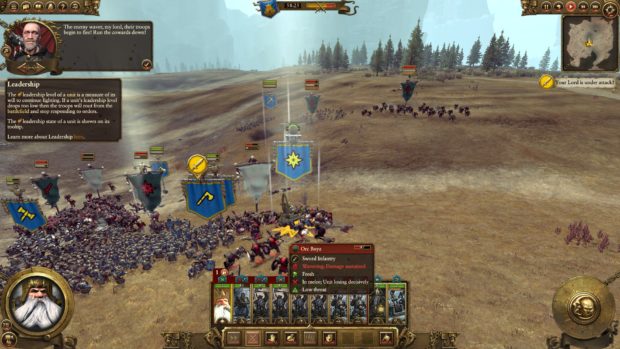
The real time battles the Total War games have been known for have never looked better. The Vampire Counts, in particular, make an awesome spectacle as they march off to war- animated skeletons all moving in exact concert, zombies shuffling along, flocks of war bats flying above, and a variety of different terrifying monsters, some large enough to break through a city’s gates all by themselves. Maps feature awesome vistas of nearby cities, or the works of underground tunnels. The biggest change map wise is to the cities. Now, instead of seeing an entire walled cities during your siege assault, the map will be limited to the battle over one section of wall, and so the siege battles depict an assault from just one side. Towers on the wall will have most of the map in range, as well, so the days of sitting from afar while your siege artillery used up all its ammo are pretty well done. Attacks happen more quickly, and with the concentration on one portion of the wall, are much more interesting and fun.
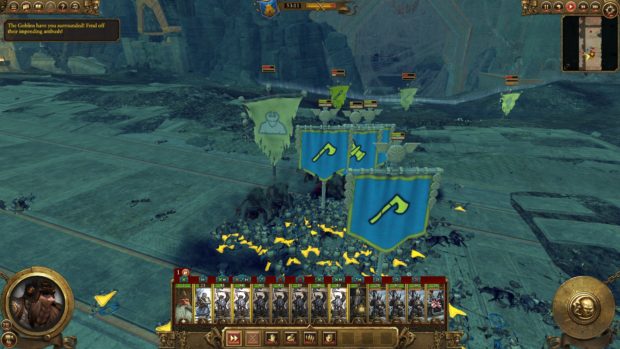
Commanding a Warhammer battle is an exercise in learning the peculiarities of the factions involved and trying to exploit them to the fullest. Greenskin armies, for example, are very unreliable- their troops tend to flee very quickly. Yet they rally almost as quickly and as unpredictably. Vampire armies are all bound to their lord- take him out, and watch as all his troops instantly disintegrate. Those same lords can often raise an entire new unit of zombies mid-battle, so they are always worth watching. There are a number of new factors to take into account in battle that you never had to measure before. Wizards will cast spells during the battle, bolstering troops, mowing down foes with arcane missiles, and generally causing havoc. Hero units can cut swathes through enemy forces, and leaders, despite an absence of bodyguards, are formidable in combat. The weirdest thing for me to adjust to was the large units. I was so used to fighting battles where all the combatants were humans. Now, a unit of 8 ogres can rip right through a unit of 60 zombies and not even break a sweat. All these details work together to provide a fresh and welcome change to the Total War battles.
The sandbox turn-based campaigns of the Total War series get an upgrade in Warhammer as well. One of the more interesting changes is the addition of quest battles. These occur periodically as the campaign go one to five per campaign. The battles include cool scripted events, like your Dwarf army being surrounded underground, or fighting off first incursion by the Empire into Vampire Count territory. These break up the repetitive monotony that sometimes takes over the Total War games, adding special battles that differ from the norm. The trouble is that they are too few in number to really don’t have much of an impact in that respect. They are interesting, but 5 battles in the scope of dozens aren’t all the many.
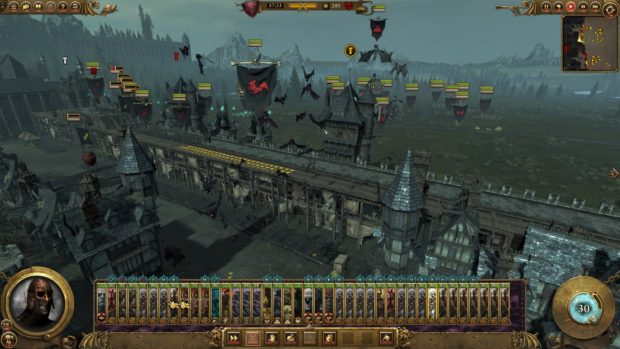
The campaign is interesting outside of that new addition. Each faction has a unique set of buildings and its own research tree. That is coupled with the fact that they are only allowed to take control of territory from only one opposing faction. That is, Vampire Counts can only add territory from the Empire (or other Vampire Counts). If they were to capture a Dwarf or Greenskin settlement, it would have to be razed or sacked. This means that you’ll always have open territory on your borders, and have to keep a watch on it for the return of your foes. Despite that necessity of watchfulness, as an experienced Total War player, I found the campaign pretty easy to navigate. The AI didn’t do a lot to pressure me, so, despite the threat of advancing Chaos, I was able to operate pretty much with impunity. I also found the Vampire Counts in particular to be over-powered. The ability to Raise the Dead meant that as long as I could keep my lords alive, I was able to constantly field large armies and wear my opponents into dust. It also meant I could be a lot more aggressive. The threat of attrition from marching through territory without sufficient Vampiric corruption was there, but muted by the fact that armies that besiege an enemy city don’t experience attrition. This meant my army was often able to move on before attrition took hold. The mid-to-late game, when Chaos was stronger and other armies seemed to gain a bit in power was a bit better, but I never felt like my existence was at stake. I had a much more challenging experience as the Dwarves, who moved slowly, and seemed to be surrounded by stronger enemies from the very beginning.They also had to deal with the more aggressive Greenskins, who are almost forced by circumstance to attack incessantly. Some factions are definitely easier to play than others.
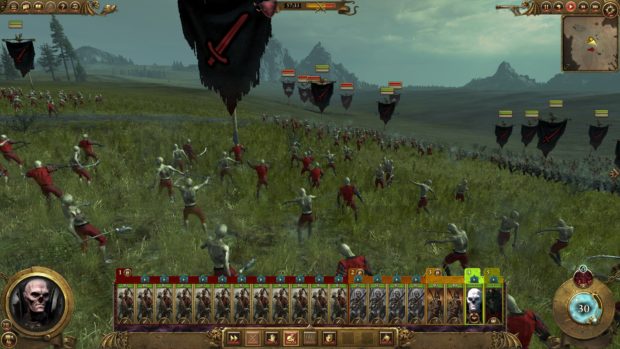
Total War: Warhammer is the first game in the series in a long time, maybe since Napoleon, that felt, not iterative, but experimental and new. It’s a great game, a fun, fantastical experience, and breaking away from history to move to the Warhammer universe is an unqualified success. I can’t help but think that there’s a lot left out in terms of factions to serve as future DLC (where are the Elves, Skaven, and Lizardmen?), but on a whole, I enjoyed conquering the realm and fighting back the forces of Chaos. This game is a much welcome new chapter in the series, and I can’t wait to see where it goes next.
